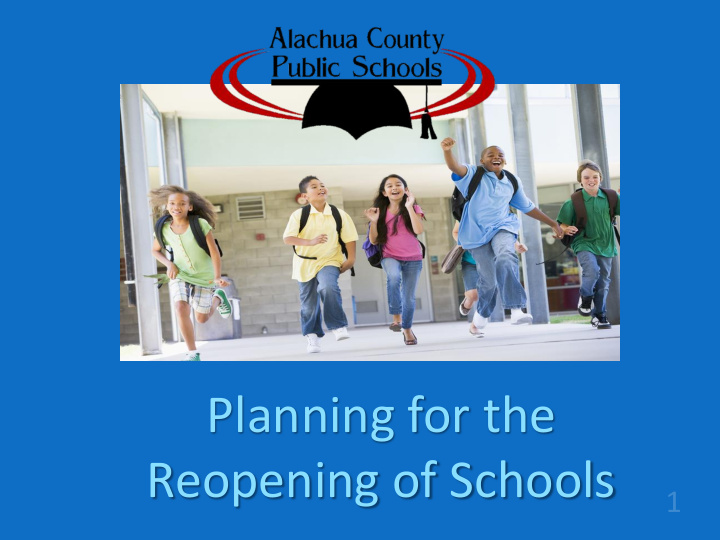



Planning for the Reopening of Schools
Considerations • Health and safety of students, staff, families and community • Level of Community Spread (Substantial, Minimal/Moderate, Low/No Spread) • Florida Department of Education guidelines (released 6/11) • Federal, state and local orders • Higher vulnerability populations (students and staff) • Economic impact on families • Educational/social emotional impact on students …and more
1 st Parent Survey (English): 11,927 responses • Plurality (35.8%) completely support return to regular, full time schedule Aug. 10 with precautions; 26.6% do not support • Plurality (30.9%) do not support waiting until Labor Day • Plurality (32%) do not support combination of face-to-face and online learning • Plurality (41.7%) do not support online learning until it is ‘safe’ to return • Majority (61.8%) do not support full-time virtual school
1 st Parent Survey (English) • Plurality (41.2%) completely support facial coverings • Plurality (43.9%) completely support social distancing • Tie for staggered days (30.1% completely support, 30.1% do not support) • Plurality (35.4%) do not support delaying the start of the school year • Majority (55.2%) do not support going to a completely online platform
1 st Parent Survey (Spanish): 171 responses • Plurality (31.6%) do not support return to regular, full time schedule Aug. 10 with precautions; 25.1% completely support • Plurality (28.7%) do not support waiting until Labor Day • Plurality (33.3%) completely support combination of face-to- face and online learning • Plurality (42.1%) completely support online learning until it is ‘safe’ to return • Majority (50.3%) do not support full-time virtual school
1 st Parent Survey (Spanish) • Majority (69.6%) completely support facial coverings • Majority (60.8%) completely support social distancing • Plurality (41.5%) completely support combination of face to face and online instruction • Plurality (43.3%) do not support delaying the start of the school year • Plurality (39.2%) do not support going to a completely online platform
Operational Issues School Logistics and Protocols Handwashing, PPE, enhanced disinfection of facilities, student/staff training, protocol for ill students/staff, etc. Transporting Students Hand sanitizing, PPE, enhanced disinfection, spaced seating (to the extent practicable), bus stop/loading protocols, etc. Entering School Buildings Screening, protocols for ill students/staff/visitors, PPE, hand sanitizing, staggered pick up/drop off, social distancing, signage, etc.
Operational Issues Serving Meals Hand washing, disposable plates, utensils, enhanced disinfection, spaced serving/seating, longer meal times, prepackaged meals, meals in classrooms, etc. Transitioning Limit mixing of students, additional transition time, staggered class changes, limiting class changes, etc. Safety of Students Enhanced disinfection of hallways, bathroom, high touch surfaces, etc.
Operational Issues Student Support Services Assessment of students’ emotional status, trauma teams, enhanced social/emotional learning, educational planning team testing/evalution, counseling/support services for students and staff, discussion of shared experiences, etc. Professional Development Additional training for teachers and staff in Trauma Informed Care, Social Emotional Learning, Digital Academy, Safe and Healthy Learning Environments, etc.
Operational Issues Extracurricular Activities FHSAA guidelines, limitations on group/crowd sizes, social distancing as practicable, temperature/symptom screening, enhanced disinfection, limited participation to certain counties/states, face coverings, etc. Protecting Vulnerable Populations Survey high-risk families and staff, consultation with Health Department/healthcare professionals, distance learning opportunities, special accommodations (PPE, early transitions, etc.)
Operational Issues Supporting Teaching and Learning • Survey families about preferred delivery: virtual learning through their school, Alachua eSchool, in person • Schedule classes to promote distancing to the extent practicable • Remove non-essential furniture to promote more distance between desks • Use larger spaces (indoor and outdoor) for instruction as possible • Avoid sharing of textbooks, supplies, toys etc. • Limit physical interaction (ie. group work)
• Establish Academic Baseline through formative assessments and teacher meetings • Implement Intervention plan to address critical skills/standards missed during school closures , students with disabilities, students who struggled with distance learning, English-language learners, other students who are behind academically • Continue to provide access to enrichment (fine arts, music, world languages, PE, STEAM, CTE, AP/IB/Cambridge, dual enrollment, etc.) • Address learning losses through before/after school programs, Saturday school, Alachua eSchool, etc.
• Develop a digital learning plan to prepare for possibility of future distance learning (digitizing lessons, digital learning days, online assignment requirements, etc. • Hybrid/blended model only to be implemented if absolutely necessary; consider allowing special education students to continue in-person instruction
Next Steps • Presentation/discussion with DAC (6/18) • Presention/discussion with ACCPTA (6/18) • Discussion with Alachua County Education Association • Consultation with Alachua County Health Department, including plans for voluntary staff testing • Posting/announcement of draft plan and special email address for input
Next Steps • Additional parent survey • Staff Survey • Board workshop: July 8 • Teacher preplanning: August 3 • Students return: August 10
Questions, discussion
Recommend
More recommend